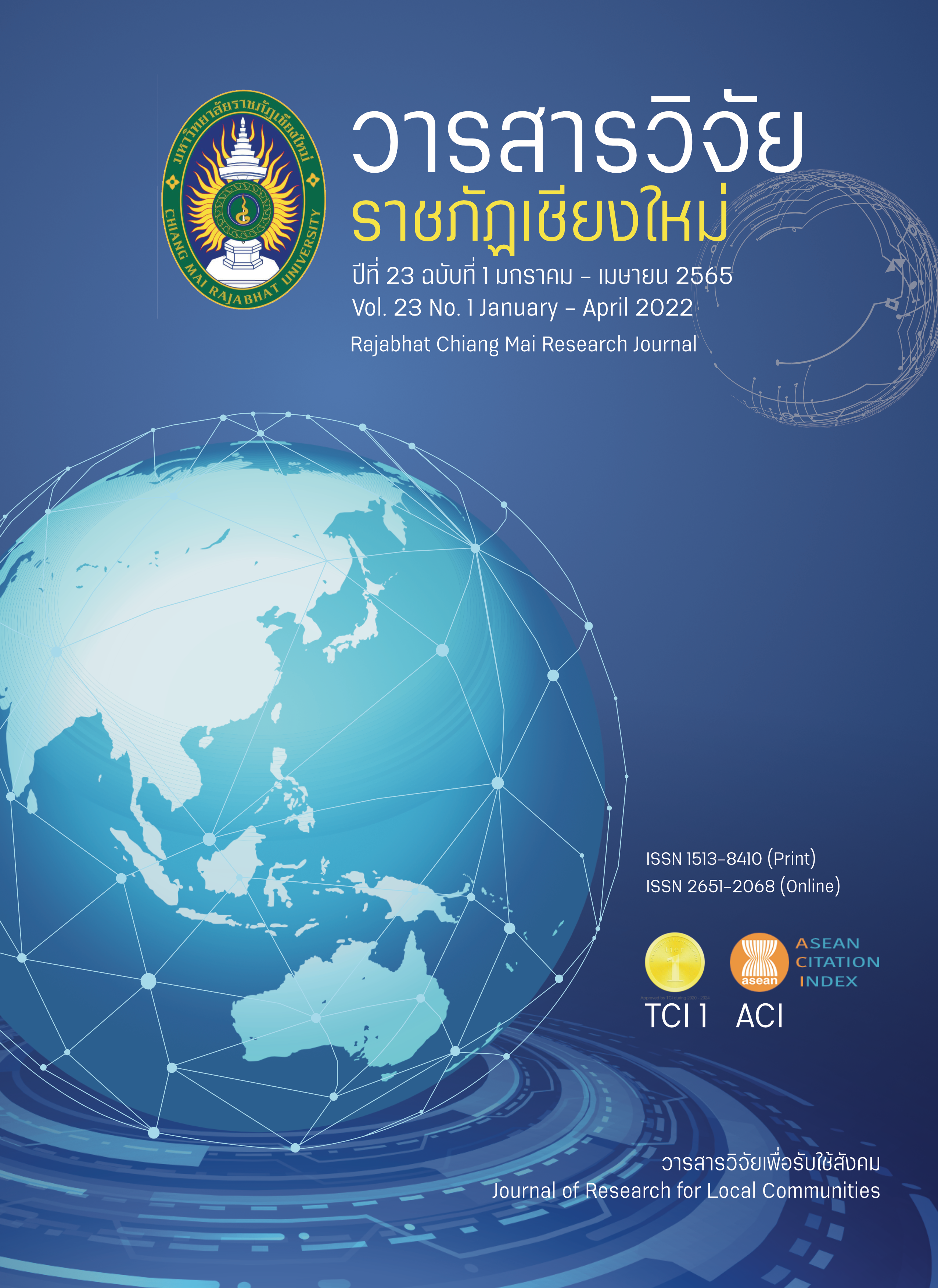การเมืองของกระบวนการกําหนดนโยบายน้ำของอินโดนีเซีย กรณีศึกษาบริเวณ Kuta และ Sanur ในจังหวัดบาหลี ประเทศอินโดนีเซีย
DOI:
https://doi.org/10.14456/rcmrj.2022.252663คำสำคัญ:
การจัดการทรัพยากรน้ำ, ประชาธิปไตยแบบปรึกษาหารือ, การมีส่วนร่วมของชุมชนบทคัดย่อ
งานวิจัยฉบับนี้ศึกษาเกี่ยวกับความขัดแย้งด้านทรัพยากรน้ำที่เกิดขึ้นในพื้นที่บริเวณ Kuta และ Sanur ในจังหวัดบาหลี ประเทศอินโดนีเซีย ซึ่งหลังจากที่ได้มีการกระจายอำนาจจากส่วนกลางไปสู่ส่วนท้องถิ่นนั้น รัฐบาลท้องถิ่นต้องพึ่งพาหรือหารายได้ด้วยตนเองมากขึ้น โดยการหารายได้ดังกล่าวอาจจะเป็นการคำนึงถึงผลประโยชน์ของฝ่ายรัฐบาลมากเกินไป จึงส่งผลกระทบต่อทั้งตัวชุมชนและผู้มีส่วนได้ส่วนเสีย สำหรับวัตถุประสงค์ในการวิจัยแบ่งออกเป็น 3 ข้อ ได้แก่ 1) เพื่อศึกษาวิวัฒนาการของการจัดสรรทรัพยากรน้ำในพื้นที่ท้องถิ่นของประเทศอินโดนีเซีย 2) เพื่อวิเคราะห์อิทธิพลของตัวแสดงที่เกี่ยวข้องในการจัดสรรทรัพยากรน้ำ 3) เพื่อวิเคราะห์รูปแบบของกระบวนการของประชาธิปไตยแบบปรึกษาหารือที่ใช้แก้ไขการจัดสรรทรัพยากรน้ำในพื้นที่ท้องถิ่นของประเทศอินโดนีเซีย งานวิจัยฉบับนี้มีสมมติฐานคือ การออกแบบเชิงสถาบัน (Institutional Design) ในการจัดการทรัพยากรน้ำ อันได้แก่ กระบวนการแสดงความคิดเห็นของชุมชน และกลุ่มผู้มีส่วนได้ส่วนเสียที่เกี่ยวข้องที่สอดคล้องกับ Deliberative Democracy หรือการสร้างความสัมพันธ์ที่มีลักษณะที่เป็นแบบ Horizontal ซึ่งจะมีศักยภาพมากกว่าลักษณะที่เป็นแบบ Vertical มีแนวโน้มที่จะลดความขัดแย้งในการจัดสรรทรัพยากรน้ำในพื้นที่ได้
ผลการวิจัยพบว่าในบริบทของบริเวณ Kuta และ Sanur ในจังหวัดบาหลี ประเทศอินโดนีเซีย ถึงแม้ว่าจะมีความไม่เสมอภาคในตอนเริ่มแรก แต่ผลประโยชน์ของชาวบ้านที่อยู่ในบริเวณที่ทรัพยากรน้ำขาดแคลนอย่างจริงจัง ก็ถูกเริ่มนำมาพิจารณาอย่างต่อเนื่องในเวทีการเจรจาหาทางออกร่วมกัน ดังนั้นจะตอบสมมติฐานได้ว่า องค์ประกอบที่นำไปสู่การจัดสรรทรัพยากรน้ำที่เท่าเทียมและทำให้ประชาชนในท้องถิ่นบริเวณ Kuta และ Sanur ในจังหวัดบาหลี ประเทศอินโดนีเซียสามารถเข้าถึงน้ำได้อย่างเท่าเทียม ไม่เกิดสภาวะการขาดแคลนน้ำ จะประกอบไปด้วย ประการที่ 1 การที่รัฐบาลท้องถิ่นรับฟังความคิดเห็นของชุมชน ประการที่ 2 กระบวนการแก้ไขความขัดแย้งที่มีลักษณะเป็น Deliberative Democracy โดยประการที่ 1 และประการที่ 2 จะเห็นได้จากการจัดตั้งคณะกรรมการด้านการบริหารจัดการน้ำ หรือ Water Management Committees (WMCs) และประการที่ 3 ความร่วมมือของกลุ่มธุรกิจในการกำหนดนโยบายด้านการจัดการทรัพยากรน้ำ ดังจะเห็นได้จากโมเดลความร่วมมือในการป้องกันน้ำใต้ดิน โดยเป็นความร่วมมือระหว่างหน่วยงานระดับภูมิภาค และระดับท้องถิ่น
Downloads
เอกสารอ้างอิง
Ardika, I., Wayan, I., Parimartha, G., & Agung, A., Wirawan, B. (2013). Sejarah Bali: Dari Pra-Sejarah Hingga Modern. Denpasar: Udayana University Press.
Arnscheidt, J. (2009). ‘Debating’ Nature Conservation: Policy, Law and Practice in Indonesia. Leiden: Leiden University Press.
Baiocchi, G. (2003). Participation, Activism, and Politics: The Porto Alegre Experiment. In Fung, Archon and Wright, Erik Olin. ed. 2003. Deepening Democracy. pp. 47-70. London: Verso.
Beetham, D. (2006). Democracy, a Beginner's Guide. Oxford: One world.
Bevir, M. (2011). Governance as Theory, Practice, and Dilemma. In The Sage Handbook of Governance, ed. Mark Bevir, 1–16. Los Angeles: Sage.
Blank, Y., & Rosen-Zvi, I., (2010). The Spatial Turn in Legal Theory. HAGAR Studies in Culture, Polity and Identities, 10(1), 37–60.
Blaug, R., & Schwarzmantel, J. (1988). Democracy: A Reader. George Square, Edinburgh : Edinburgh University Press. pp. 6-8.
Blomley, N. (1994). Law, Space and the Geographies of Power. New York: Guilford Press.
Blomquist, W., & Schlager, E. (2005). Political Pitfalls of Integrated Watershed Management. In Society & Natural Resources: An International Journal, 18(2), 101-117.
Bohman, J. (1996). Public Deliberation: Pluralism, Complexity and Democracy. Cambridge, MA: MIT Press. Cited in Owen, David S. 2001. "Review Essay Deliberative Democracy." Philosophy & Social Criticism, 27(5), 117-124.
Bohman, J., & William, R. (1997). Deliberative Democracy: Essays on Reason and Politics. Cambridge, Massachusetts: the MIT Press.
Bowman, M. (2002). The Ramsar Convention on Wetlands: Has It Made a Difference? Yearbook of International Co-operation on Environment and Development 2002/2003.
Brown, R. (2005). Impediments to Integrated Urban Stormwater Management: The Need for Institutional Reform. In Environmental Management, 36(3), 455-468.
Brown, R.R., Ashley, R., & Farrelly, M.A. (2011). Political and professional agency entrapment: an agenda for urban water research. In Water Resources Management, 25(15), 4037-4050.
Castro, J.E., Kaika, M., & Swyngedouw, E. (2003). London: Structural Continuities and Institutional Change in Water Management. In European Planning Studies, 11(3), 283-298.
Desa, P. (2007). Profil Desa Pecatu, Kecamatan Kuta Selatan, Kabupaten Badung, Provinsi Bali, Tahun 2008. Jakarta: Departemen Dalam Negeri, Dirjen Pemberdayaan Masyarakat dan Desa.
Kumler. L. M., & Lemos, M.C. (2008). Managing waters of the Paraíba do Sul river basin, Brazil: a case study in institutional change and social learning. In Ecology and Society, 13(2), 22.
Laurajane, S. (2006). Uses of Heritage. London: Routledge.
Lees, S. H. (2001). Kicking Off the Kaiko: Instability, Opportunism, and Crisis in Ecological Anthropology. In Ecology and the Sacred: Engaging the Anthropology of Roy A. Rappaport, ed. E. Messer and M. Lambek, 49–63. Michigan: University of Michigan Press.
Lefebvre, H. (1991). Production of Space. Oxford: Blackwell.
Lemos, M. C., & Oliveira, J.L.F. (2004). Can Water Reform Survive Politics? Institutional Change and River Basin Management in Ceara´, Northeast Brazil. In World Development, 32(12), 2121-2137.
Lewis, J., & Belinda, L. (2009). Bali’s Silent Crisis: Desire, Tragedy, and Transition. Lanham and Plymouth: Lexington Books.
Liefrinck, F.A. (1969). Rice Cultivation in Northern Bali. In Bali: Further Studies in Life, Thought, and Ritual, 3–4. The Hague: W. Van Hoeve.
ดาวน์โหลด
เผยแพร่แล้ว
รูปแบบการอ้างอิง
ฉบับ
ประเภทบทความ
สัญญาอนุญาต
ลิขสิทธิ์ (c) 2022 วารสารวิจัยราชภัฏเชียงใหม่

อนุญาตภายใต้เงื่อนไข Creative Commons Attribution-NonCommercial-NoDerivatives 4.0 International License.
1. บทความ ข้อมูล เนื้อหา รูปภาพ ฯลฯ ที่ได้รับการตีพิมพ์ใน “Community and Social Development Journal” ถือเป็นลิขสิทธิ์ของ Community and Social Development Journal มหาวิทยาลัยราชภัฏเชียงใหม่ และเพื่อให้เผยแพร่บทความได้อย่างเหมาะสมผ่านสื่อสิ่งพิมพ์และอิเล็กทรอนิกส์ ผู้เขียนยังคงถือครองลิขสิทธิ์บทความที่ตีพิมพ์ภายใต้ใบอนุญาต Creative Commons Attribution (CC BY) ซึ่งอนุญาตให้เผยแพร่บทความซ้ำในแหล่งอื่นได้ โดยอ้างอิงต้องอ้งอิงบทความในวารสาร ผู้เขียนต้องรับผิดชอบในการขออนุญาตผลิตซ้ำเนื้อหาที่มีลิขสิทธิ์จากแหล่งอื่น
2. เนื้อหาบทความที่ปรากฏในวารสารเป็นความรับผิดชอบของผู้เขียนบทความโดยตรง ซึ่งกองบรรณาธิการวารสารไม่จำเป็นต้องเห็นด้วยหรือร่วมรับผิดชอบใดๆ














